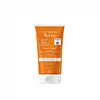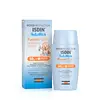What's inside
What's inside
 Key Ingredients
Key Ingredients

 Benefits
Benefits

 Concerns
Concerns

 Ingredients Side-by-side
Ingredients Side-by-side

Water
Skin ConditioningC12-15 Alkyl Benzoate
AntimicrobialCaprylic/Capric Triglyceride
MaskingDicaprylyl Carbonate
EmollientDiethylamino Hydroxybenzoyl Hexyl Benzoate
UV FilterGlycerin
HumectantEthylhexyl Triazone
UV AbsorberPhenylene Bis-Diphenyltriazine
StabilisingBis-Ethylhexyloxyphenol Methoxyphenyl Triazine
Skin ConditioningPotassium Cetyl Phosphate
EmulsifyingStearyl Alcohol
EmollientVp/Eicosene Copolymer
Benzoic Acid
MaskingCaprylyl Glycol
EmollientGlyceryl Behenate
EmollientGlyceryl Dibehenate
EmollientGlyceryl Stearate
EmollientPEG-100 Stearate
Polyacrylate-13
Polyisobutene
Polysorbate 20
EmulsifyingPPG-1-PEG-9 Lauryl Glycol Ether
EmulsifyingCI 17200
Cosmetic ColorantSorbitan Isostearate
EmulsifyingTocopherol
AntioxidantTocopheryl Glucoside
EmollientTribehenin
EmollientXanthan Gum
EmulsifyingWater, C12-15 Alkyl Benzoate, Caprylic/Capric Triglyceride, Dicaprylyl Carbonate, Diethylamino Hydroxybenzoyl Hexyl Benzoate, Glycerin, Ethylhexyl Triazone, Phenylene Bis-Diphenyltriazine, Bis-Ethylhexyloxyphenol Methoxyphenyl Triazine, Potassium Cetyl Phosphate, Stearyl Alcohol, Vp/Eicosene Copolymer, Benzoic Acid, Caprylyl Glycol, Glyceryl Behenate, Glyceryl Dibehenate, Glyceryl Stearate, PEG-100 Stearate, Polyacrylate-13, Polyisobutene, Polysorbate 20, PPG-1-PEG-9 Lauryl Glycol Ether, CI 17200, Sorbitan Isostearate, Tocopherol, Tocopheryl Glucoside, Tribehenin, Xanthan Gum
Water
Skin ConditioningDicaprylyl Carbonate
EmollientDiethylhexyl Carbonate
EmollientCyclopentasiloxane
EmollientDibutyl Adipate
EmollientTitanium Dioxide
Cosmetic ColorantZinc Oxide
Cosmetic ColorantAlcohol Denat.
AntimicrobialCyclohexasiloxane
EmollientButylene Glycol
HumectantPEG-30 Dipolyhydroxystearate
EmulsifyingNylon-12
Dimethicone
EmollientPEG-10 Dimethicone
Skin ConditioningSodium Chloride
MaskingSilica
AbrasivePhenoxyethanol
PreservativeDisteardimonium Hectorite
StabilisingAllantoin
Skin ConditioningGlyceryl Stearate
EmollientTocopheryl Acetate
AntioxidantTriethoxycaprylylsilane
Disodium EDTA
Sodium Hyaluronate
HumectantEthylhexylglycerin
Skin ConditioningPEG-8
HumectantTocopherol
AntioxidantAscorbyl Palmitate
AntioxidantAscorbic Acid
AntioxidantCitric Acid
BufferingWater, Dicaprylyl Carbonate, Diethylhexyl Carbonate, Cyclopentasiloxane, Dibutyl Adipate, Titanium Dioxide, Zinc Oxide, Alcohol Denat., Cyclohexasiloxane, Butylene Glycol, PEG-30 Dipolyhydroxystearate, Nylon-12, Dimethicone, PEG-10 Dimethicone, Sodium Chloride, Silica, Phenoxyethanol, Disteardimonium Hectorite, Allantoin, Glyceryl Stearate, Tocopheryl Acetate, Triethoxycaprylylsilane, Disodium EDTA, Sodium Hyaluronate, Ethylhexylglycerin, PEG-8, Tocopherol, Ascorbyl Palmitate, Ascorbic Acid, Citric Acid
 Reviews
Reviews

Ingredients Explained
These ingredients are found in both products.
Ingredients higher up in an ingredient list are typically present in a larger amount.
Dicaprylyl Carbonate comes from carbonic acid and caprylyl alcohol, a fatty alcohol. It is an emollient and gives skin a velvet feel. The sources of Dicaprylyl Carbonate may be synthetic or from animals.
As an emollient, Dicaprylyl Carbonate creates a film on the skin. This film traps moisture in, keeping your skin soft and hydrated.
Glyceryl Stearate is a mix of glycerin and stearic acid.
It is used to stabilize the mixing of water and oil ingredients. By preventing these ingredients from separating, it can help elongate shelf life. It can also help thicken the product's texture.
As an emollient, it helps soften skin and supports barrier-replenishing ingredients.
In cosmetics, Glyceryl Stearate is often made from vegetable oils or synthetically produced.
This ingredient may not be fungal-acne safe
Fun fact: The human body also creates Glyceryl Stearate naturally.
Learn more about Glyceryl StearateTocopherol (also known as Vitamin E) is a common antioxidant used to help protect the skin from free-radicals and strengthen the skin barrier. It's also fat soluble - this means our skin is great at absorbing it.
Vitamin E also helps keep your natural skin lipids healthy. Your lipid skin barrier naturally consists of lipids, ceramides, and fatty acids. Vitamin E offers extra protection for your skin’s lipid barrier, keeping your skin healthy and nourished.
Another benefit is a bit of UV protection. Vitamin E helps reduce the damage caused by UVB rays. (It should not replace your sunscreen). Combining it with Vitamin C can decrease sunburned cells and hyperpigmentation after UV exposure.
You might have noticed Vitamin E + C often paired together. This is because it is great at stabilizing Vitamin C. Using the two together helps increase the effectiveness of both ingredients.
There are often claims that Vitamin E can reduce/prevent scarring, but these claims haven't been confirmed by scientific research.
Learn more about TocopherolWater. It's the most common cosmetic ingredient of all. You'll usually see it at the top of ingredient lists, meaning that it makes up the largest part of the product.
So why is it so popular? Water most often acts as a solvent - this means that it helps dissolve other ingredients into the formulation.
You'll also recognize water as that liquid we all need to stay alive. If you see this, drink a glass of water. Stay hydrated!
Learn more about Water